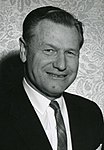| |||||||||||||||||||
| |||||||||||||||||||
 Results map by state. | |||||||||||||||||||
| |||||||||||||||||||
From March 8 to June 7, 1960, voters of the Republican Party chose its nominee for president in the 1960 United States presidential election. Incumbent Vice President Richard Nixon was selected as the nominee through a series of primary elections and caucuses culminating in the 1960 Republican National Convention held from July 25 to July 28, 1960, in Chicago, Illinois. [1]
Contents
- Candidates
- Nominee
- Other major candidates
- Favorite sons
- Declined to run
- Polling
- National polling
- Statewide contests by winner
- Total popular vote results
- See also
- References
At this time, primaries were not conclusive in deciding a party's nominee. However, Nixon faced no formidable opposition. He swept the primaries without difficulty and received the nomination unanimously at the July convention. He was briefly opposed by Governor Nelson Rockefeller of New York, who withdrew and endorsed Nixon after struggling in the polls.






